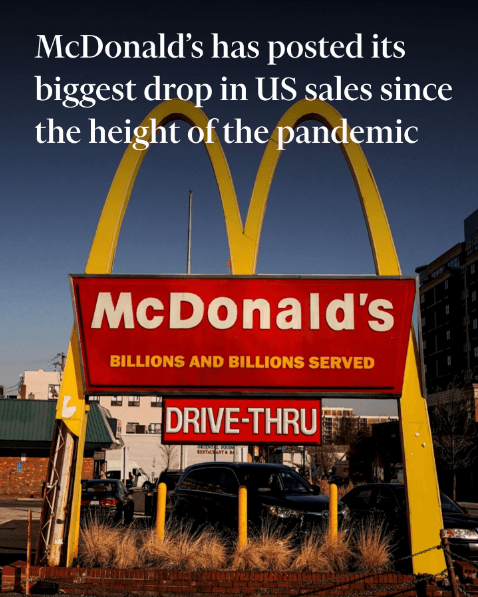
McDonald's posts biggest drop in US sales since pandemic
So Much for the Recession-Proof Myth! McDonald’s U.S. same-store sales just fell for the first time since 2020, marking the steepest domestic pullback since the pandemic—and confirming a trend CenterCheck’s sales data started flagging back in January.
Consumer spending across quick-service burger chains dropped 2.4% quarter-over-quarter, according to CenterCheck’s credit and debit card transaction analysis, with McDonald’s sales underperforming the category average by nearly 100 basis points. That makes it one of the only major QSR brands to contract during a period when inflation, high rates, and price sensitivity were supposed to be driving diners toward “value” concepts.
Instead, the opposite is happening. McDonald’s, long considered an “inferior good”—an economic term for products that gain share when wallets tighten—is losing both sales and transaction count. And the usual trade-down effect isn’t kicking in.
In the lowest-income decile zip codes, McDonald’s retail sales fell 4.3% year-over-year, a bigger decline than in any other income tier, per CenterCheck’s geographically weighted spend data. Among customers spending less than $10 per transaction, sales dropped 5.1%, signaling an erosion of the chain’s most price-sensitive consumer base.
Why? The brand isn’t cheap anymore. The average McDonald’s check now clocks in at $9.82, up 22% since 2020, with no return of a true national value menu. Meanwhile, grocery inflation has cooled to just 1.2%, making at-home meals more compelling again. McDonald’s is still raising menu prices—up 4.8% year-over-year—but customers aren’t following. Same-store transaction volume in the U.S., based on CenterCheck’s anonymized card swipe data, is down 6.3% since last year’s peak.
McDonald’s hoped its digital playbook—app offers, AI-powered ordering, loyalty points—would drive repeat visits. And yet, despite a loyalty program now exceeding 50 million users, transaction frequency among known McDonald’s cardholders has dropped from 3.1 to 2.7 visits per month over the past two quarters. That’s not a stickier customer. That’s a disengaged one.
In January, CenterCheck data showed a clear deceleration in retail spend across fast food, but McDonald’s stood out for the scale of its drop. Sales at value-tier competitors like Wendy’s and Burger King remained flat or slightly positive, while Taco Bell saw low single-digit growth. But McDonald’s posted declines in both total spend and average transaction count—long before this week’s earnings confirmed it.
So where is the trade-down consumer going? Some to lower-priced QSRs. Many, we believe, are skipping dining out entirely. CenterCheck data shows a 5.7% increase in sub-$20 grocery store purchases in the same low-income zip codes where McDonald’s lost ground. Consumers aren’t trading down from restaurants. They’re trading out.
The bottom line? If McDonald’s is no longer capturing the trade-down customer, it’s not an “inferior good.” It’s just another brand exposed to the full force of consumer disillusionment, pricing fatigue, and changing behavior.
This isn't a one-off quarter. It’s a shift.